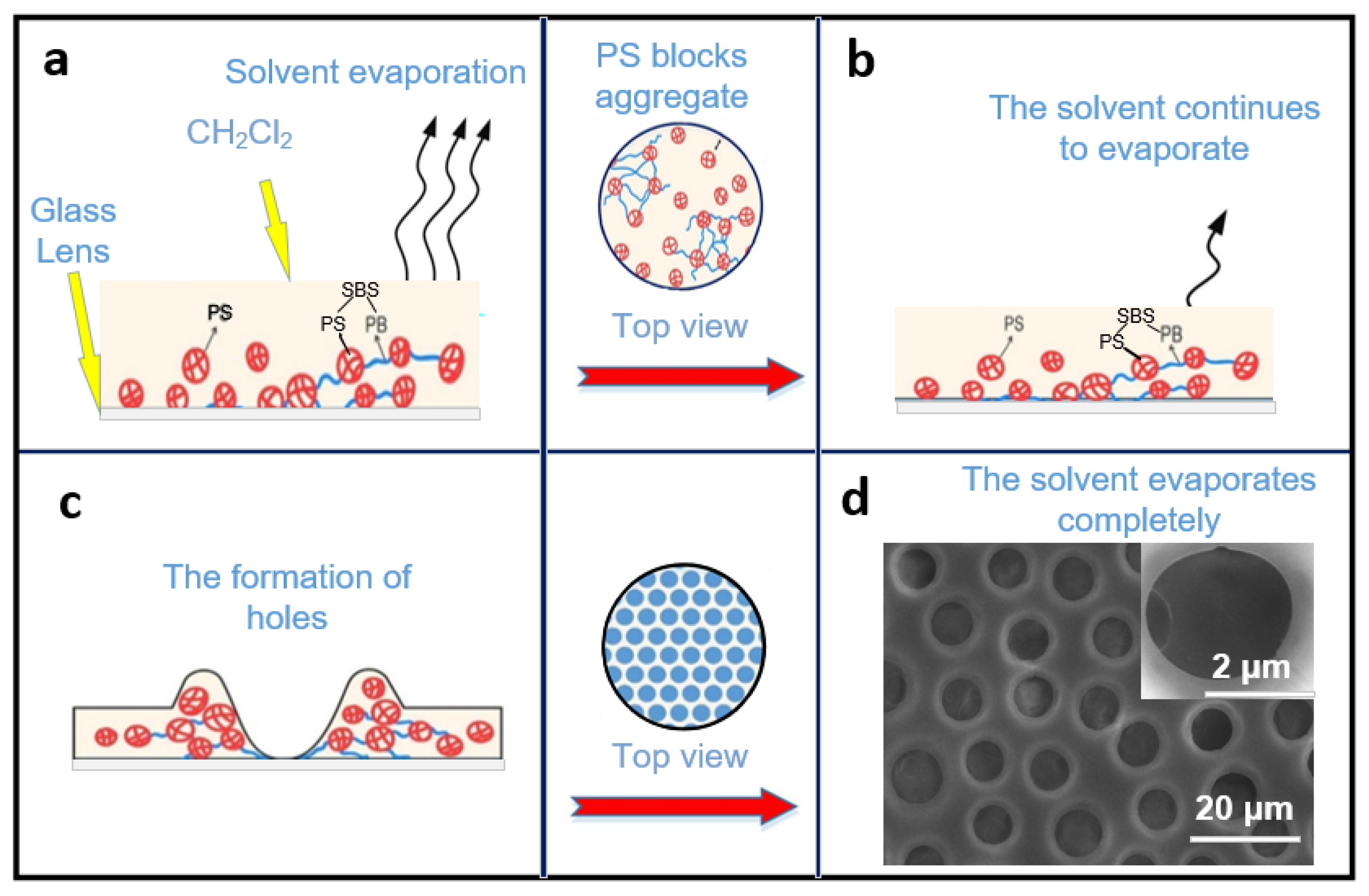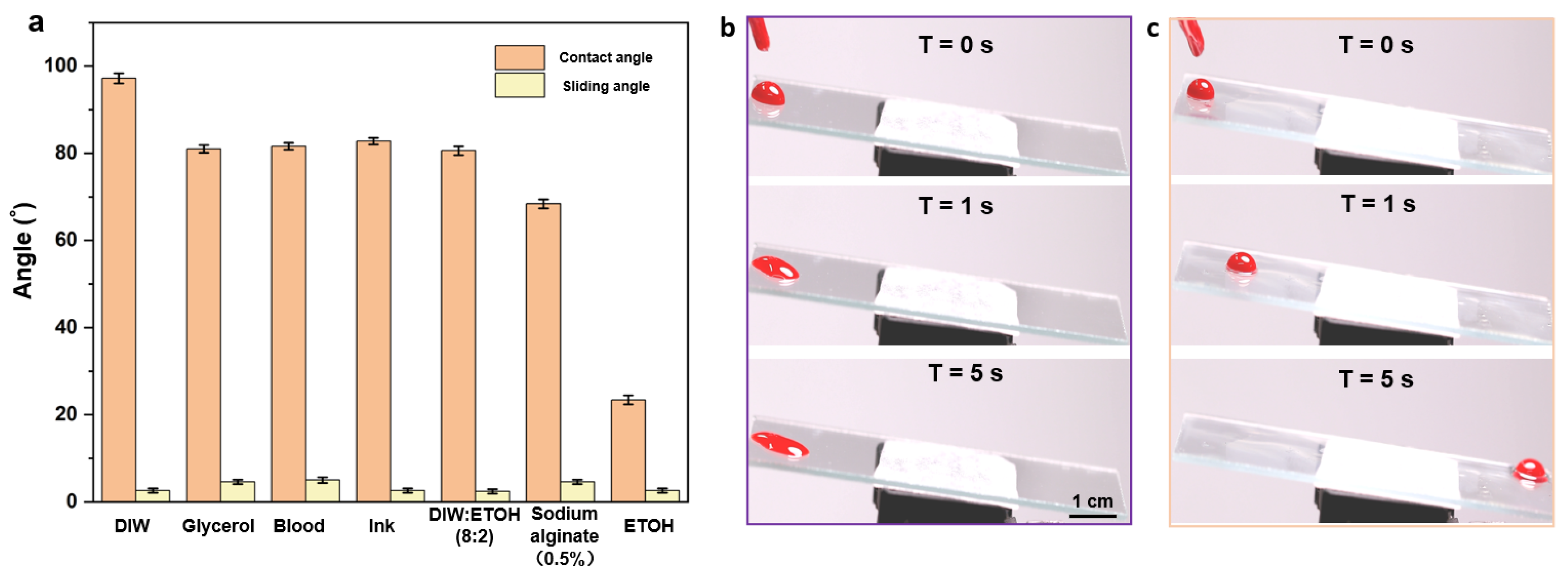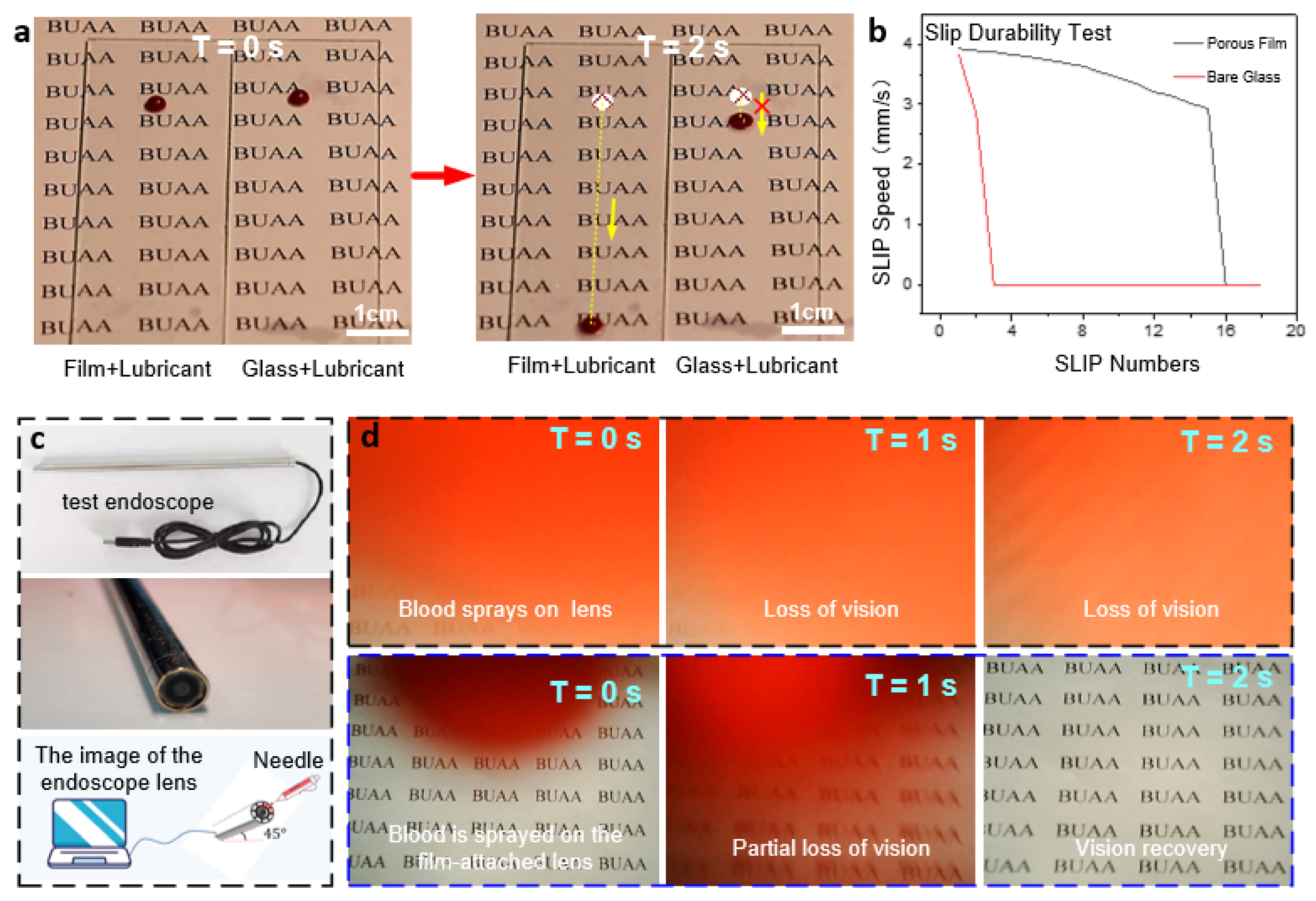Liquid-Infused Porous Film Self-Assembly for Superior Light-Transmitting and Anti-Adhesion
Abstract
:1. Introduction
2. Materials and Methods
3. Results
3.1. Formation Mechanism
3.2. Influence of Concentration
3.3. Influence of Spin Coating Speed
3.4. Light Transmission Performance
3.5. Anti-Adhesive Properties
3.6. Comprehensive Performance
4. Discussion
Supplementary Materials
Author Contributions
Funding
Institutional Review Board Statement
Informed Consent Statement
Conflicts of Interest
References
- Fang, Y.; Han, E.; Zhang, X.-X.; Jiang, Y.; Lin, Y.; Shi, J.; Wu, J.; Meng, L.; Gao, X.; Griffin, P.J.; et al. Dynamic and Programmable Cellular-Scale Granules Enable Tissue-like Materials. Matter 2020, 2, 948–964. [Google Scholar] [CrossRef]
- Fang, Y.; Yang, X.; Lin, Y.; Shi, J.; Prominski, A.; Clayton, C.; Ostroff, E.; Tian, B. Dissecting Biological and Synthetic Soft–Hard Interfaces for Tissue-Like Systems. Chem. Rev. 2021, 122, 5233–5276. [Google Scholar] [CrossRef] [PubMed]
- Lin, Y.; Fang, Y.; Yue, J.; Tian, B. Soft–Hard Composites for Bioelectric Interfaces. Trends Chem. 2020, 2, 519–534. [Google Scholar] [CrossRef] [PubMed]
- Sunny, S.; Cheng, G.; Daniel, D.; Lo, P.; Ochoa, S.; Howell, C.; Vogel, N.; Majid, A.; Aizenberg, J. Transparent antifouling material for improved operative field visibility in endoscopy. Proc. Natl. Acad. Sci. USA 2016, 113, 11676–11681. [Google Scholar] [CrossRef] [PubMed] [Green Version]
- Yu, E.; Kim, S.C.; Lee, H.J.; Oh, K.H.; Moon, M.-W. Extreme wettability of nanostructured glass fabricated by non-lithographic, anisotropic etching. Sci. Rep. 2015, 5, 9362. [Google Scholar] [CrossRef] [PubMed] [Green Version]
- Sotiri, I.; Overton, J.; Waterhouse, A.; Howell, C. Immobilized liquid layers: A new approach to anti-adhesion surfaces for medical applications. Exp. Biol. Med. 2016, 241, 909–918. [Google Scholar] [CrossRef]
- Howell, C.; Grinthal, A.; Sunny, S.; Aizenberg, M.; Aizenberg, J. Designing Liquid-Infused Surfaces for Medical Applications: A Review. Adv. Mater. 2018, 30, e1802724. [Google Scholar] [CrossRef]
- Qiu, R.; Zhang, Q.; Wang, P.; Jiang, L.; Hou, J.; Guo, W.; Zhang, H. Fabrication of slippery liquid-infused porous surface based on carbon fiber with enhanced corrosion inhibition property. Colloids Surf. A Physicochem. Eng. Asp. 2014, 453, 132–141. [Google Scholar] [CrossRef]
- Qiu, R.; Zhang, D.; Wang, P. Superhydrophobic-carbon fibre growth on a zinc surface for corrosion inhibition. Corros. Sci. 2013, 66, 350–359. [Google Scholar] [CrossRef]
- Han, K.; Heng, L.; Jiang, L. Multiphase Media Antiadhesive Coatings: Hierarchical Self-Assembled Porous Materials Generated Using Breath Figure Patterns. ACS Nano 2016, 10, 11087–11095. [Google Scholar] [CrossRef]
- Dyke, P.V.; Havard, D.; Laneville, A. Effect of Ice and Snow on the Dynamics of~Transmission Line Conductors. In Atmospheric Icing of Power Networks; Springer: Dordrecht, The Netherlands, 2008; pp. 171–228. [Google Scholar]
- Mohseni, M.; Amirfazli, A. A novel electro-thermal anti-icing system for fiber-reinforced polymer composite airfoils. Cold Reg. Sci. Technol. 2013, 87, 47–58. [Google Scholar] [CrossRef]
- Leslie, D.C.; Waterhouse, A.; Hicks-Berthet, J.B.; Valentin, T.M.; Watters, A.L.; Jain, A.; Kim, P.; Hatton, B.D.; Nedder, A.; Donovan, K.; et al. A bioinspired omniphobic surface coating on medical devices prevents thrombosis and biofouling. Nat. Biotechnol. 2014, 32, 1134–1140. [Google Scholar] [CrossRef] [PubMed]
- Harding, J.L.; Reynolds, M.M. Combating medical device fouling. Trends Biotechnol. 2014, 32, 140–146. [Google Scholar] [CrossRef] [PubMed]
- Wang, Z.; Heng, L.; Jiang, L. Effect of lubricant viscosity on the self-healing properties and electrically driven sliding of droplets on anisotropic slippery surfaces. J. Mater. Chem. A 2018, 6, 3414–3421. [Google Scholar] [CrossRef]
- Yong, J.; Chen, F.; Yang, Q.; Fang, Y.; Huo, J.; Zhang, J.; Hou, X. Nepenthes Inspired Design of Self-Repairing Omniphobic Slippery Liquid Infused Porous Surface (SLIPS) by Femtosecond Laser Direct Writing. Adv. Mater. Interfaces 2017, 4, 1–7. [Google Scholar] [CrossRef]
- Jin, B.; Liu, M.; Zhang, Q.; Zhan, X.; Chen, F. Silicone Oil Swelling Slippery Surfaces Based on Mussel-Inspired Magnetic Nanoparticles with Multiple Self-Healing Mechanisms. Langmuir 2017, 33, 10340–10350. [Google Scholar] [CrossRef]
- Hao, C.; Liu, Y.; Chen, X.; He, Y.; Li, Q.; Li, K.Y.; Wang, Z. Electrowetting on liquid-infused film (EWOLF): Complete reversibility and controlled droplet oscillation suppression for fast optical imaging. Sci. Rep. 2015, 4, 6846. [Google Scholar] [CrossRef] [Green Version]
- Brabcova, Z.; McHale, G.; Wells, G.G.; Brown, C.V.; Newton, M.I. Electric field induced reversible spreading of droplets into films on lubricant impregnated surfaces. Appl. Phys. Lett. 2017, 110, 121603. [Google Scholar] [CrossRef]
- He, X.; Qiang, W.; Du, C.; Shao, Q.; Zhang, X.; Deng, Y. Modification of lubricant infused porous surface for low-voltage reversible electrowetting. J. Mater. Chem. A 2017, 5, 19159–19167. [Google Scholar] [CrossRef]
- Villegas, M.; Zhang, Y.; Abu Jarad, N.; Soleymani, L.; Didar, T.F. Liquid-Infused Surfaces: A Review of Theory, Design, and Applications. ACS Nano 2019, 13, 8517–8536. [Google Scholar] [CrossRef]
- Kuai, S.L.; Hu, X.F.; Truong, V.V. Synthesis of thin film titania photonic crystals through an infiltrating sol-gel process. J. Cryst. Growth 2015, 259, 404–410. [Google Scholar] [CrossRef]
- Zhi-Guang, L.; Xiao-Yan, M.; Qing, H.; Xing-Hua, G. Functional Applications of Ordered Honeycomb-Patterned Porous Films Based on the Breath Figure Technique. Acta Phys. -Chim. Sin. 2015, 31, 393–411. [Google Scholar] [CrossRef]
- Song, X.; Zhang, Z.; Chen, Z.; Chen, Y. Porous Structure Fabrication Using a Stereolithography-Based Sugar Foaming Method. J. Manuf. Sci. Eng. 2016, 139, 031015. [Google Scholar] [CrossRef]
- Hirai, Y.; Yanagi, N.; Shimomura, M. Preparations of the Artificial Plastron Device by Self-Organized Honeycomb-Patterned Films. e-J. Surf. Sci. Nanotechnol. 2015, 13, 90–92. [Google Scholar] [CrossRef] [Green Version]
- Hung, T.-Y.; Liu, A.-C.; Lee, W.H.; Li, J.-R. Hierarchical Nanoparticle Assemblies Formed via One-Step Catalytic Stamp Pattern Transfer. ACS Appl. Mater. Interfaces 2019, 11, 4667–4677. [Google Scholar] [CrossRef] [PubMed]
- Hiroshi, Y. Fabrication of honeycomb films by the breath figure technique and their applications. Sci. Technol. Adv. Mater. 2018, 19, 802–822. [Google Scholar]
- Liu, G.; Zhang, P.; Chen, H.; Han, Z.; Zhang, D. Bio-inspired Anti-adhesion Surfaces of Electrosurgical Scalpel. J. Mech. Eng. 2018, 54, 21–27.17. (In Chinese) [Google Scholar] [CrossRef]
- Ueno, H.; Inoue, M.; Okonogi, A.; Kotera, H.; Suzuki, T. Correlation between Cells-on-Chips materials and cell adhesion/proliferation focused on material’s surface free energy. Colloids Surf. A Physicochem. Eng. Asp. 2019, 565, 188–194. [Google Scholar] [CrossRef]
- Lee, Y.; Chung, Y.-W.; Park, J.; Park, K.; Seo, Y.; Hong, S.-N.; Lee, S.H.; Jeon, H.; Seo, J. Lubricant-infused directly engraved nano-microstructures for mechanically durable endoscope lens with anti-biofouling and anti-fogging properties. Sci. Rep. 2020, 10, 1–11. [Google Scholar] [CrossRef]
- Yin, H.; Wang, X.; Sheng, G.; Chan, W.; Lai, Z. A facile single-step fabrication of robust super-hydrophobic carbon nanotube films on different porous supports. Ind. Eng. Chem. Res. 2019, 58, 2976–2982. [Google Scholar] [CrossRef]
- Yang, L.; Xu, Q.; Lyons, A.M. Durable, optically transparent, superhydrophobic polymer films. Appl. Surf. Sci. 2019, 470, 187–195. [Google Scholar] [CrossRef]
- Duan, Z.; Luo, D.; Liu, Z.; Zhao, Z.; Zhao, M.; Zhang, J.; Zhao, G. Patterning ZrO2 films surface: Superhydrophilic and superhydrophobic properties. Ceram. Int. 2017, 43, 5089–5094. [Google Scholar] [CrossRef]
- Ramezani, M.; Vaezi, M.R.; Kazemzadeh, A. Preparation of silane-functionalized silica films via two-step dip coating sol–gel and evaluation of their superhydrophobic properties. Appl. Surf. Sci. 2014, 317, 147–153. [Google Scholar] [CrossRef]
- Heinonen, S.; Huttunen-Saarivirta, E.; Nikkanen, J.-P.; Raulio, M.; Priha, O.; Laakso, J.; Storgårds, E.; Levänen, E. Antibacterial properties and chemical stability of superhydrophobic silver-containing surface produced by sol-gel route. Colloids Surf. A Physicochem. Eng. Asp. 2014, 453, 149–161. [Google Scholar] [CrossRef]
- Jiang, Q. Functionalised Macroporous Films via Emulsion Templating: Preparation, Processing and Applications. Ph.D. Thesis, Imperial College London, London, UK, November 2012. [Google Scholar]
- Li, Y.; Men, X.; Zhu, X.; Ge, B.; Chu, F.; Zhang, Z. One-step spraying to fabricate nonfluorinated superhydrophobic coatings with high transparency. J. Mater. Sci. 2016, 51, 2411–2419. [Google Scholar] [CrossRef]
- Liu, Y.; Deng, J.; Wang, Y.; Zhan, X.; Zhang, D.; Chen, H. Self-Assembly of Self-Cleaning Polystyrene/Styrene-Butadiene-Styrene Films with Well-Ordered Micro-Structures. Coatings 2020, 10, 1133. [Google Scholar] [CrossRef]
- Adhikari, R.; Huy, T.A.; Buschnakowski, M.; Michler, G.H.; Knoll, K. Asymmetric PS-block-(PS-co-PB)-block-PS block copolymers: Morphology formation and deformation behaviour. New J. Phys. 2004, 6, 28. [Google Scholar] [CrossRef] [Green Version]
- Wang, L.; Sun, Y.; Che, G.; Li, Z. Self-assembled silver nanoparticle films at an air–liquid interface and their applications in SERS and electrochemistry. Appl. Surf. Sci. 2011, 257, 7150–7155. [Google Scholar] [CrossRef]
- Cheyne, R.B.; Moffitt, M.G. Novel Two-Dimensional “Ring and Chain” Morphologies in Langmuir−Blodgett Monolayers of PS-b-PEO Block Copolymers: Effect of Spreading Solution Concentration on Self-Assembly at the Air−Water Interface. Langmuir 2005, 21, 5453–5460. [Google Scholar] [CrossRef]
- Cheyne, R.B.; Moffitt, M.G. Self-assembly of polystyrene-block-poly(ethylene oxide) copolymers at the air-water interface: Is dewetting the genesis of surface aggregate formation? Langmuir Acs J. Surf. Colloids 2006, 22, 8387–8396. [Google Scholar] [CrossRef]
- Kim, J.H.; Lee, H.K.; Na, J.Y.; Kim, S.-K.; Yoo, Y.-Z.; Seong, T.-Y. Dependence of Optical and Electrical Properties on Ag Thickness in TiO2/Ag/TiO2 Multilayer Films for Photo Voltaic Devices. Ceram. Int. 2015, 41, 8059–8063. [Google Scholar] [CrossRef]






Publisher’s Note: MDPI stays neutral with regard to jurisdictional claims in published maps and institutional affiliations. |
© 2022 by the authors. Licensee MDPI, Basel, Switzerland. This article is an open access article distributed under the terms and conditions of the Creative Commons Attribution (CC BY) license (https://creativecommons.org/licenses/by/4.0/).
Share and Cite
Liu, Y.; Zhan, X.; Wang, Y.; Liu, G.; Zhang, D.; Zhang, L.; Chen, H. Liquid-Infused Porous Film Self-Assembly for Superior Light-Transmitting and Anti-Adhesion. Micromachines 2022, 13, 540. https://doi.org/10.3390/mi13040540
Liu Y, Zhan X, Wang Y, Liu G, Zhang D, Zhang L, Chen H. Liquid-Infused Porous Film Self-Assembly for Superior Light-Transmitting and Anti-Adhesion. Micromachines. 2022; 13(4):540. https://doi.org/10.3390/mi13040540
Chicago/Turabian StyleLiu, Yang, Xiaoyang Zhan, Yan Wang, Guang Liu, Deyuan Zhang, Liwen Zhang, and Huawei Chen. 2022. "Liquid-Infused Porous Film Self-Assembly for Superior Light-Transmitting and Anti-Adhesion" Micromachines 13, no. 4: 540. https://doi.org/10.3390/mi13040540





